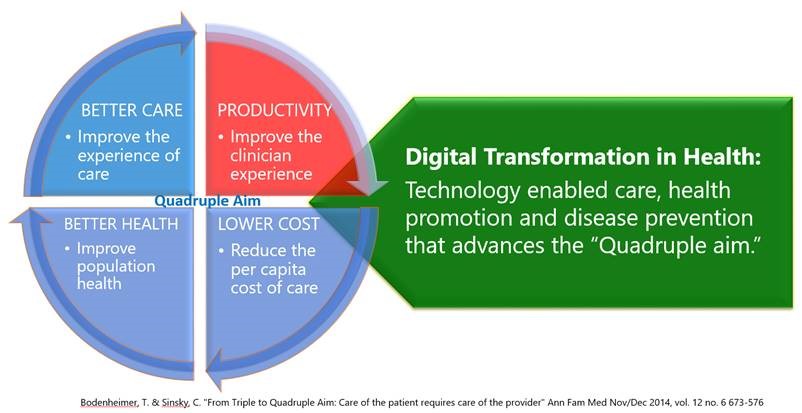PHI in the Azure cloud: driving real healthcare digital transformation now.
by Hector Rodriguez of Worldwide Health CISO & Standards, Microsoft
At Microsoft our medical experts including Dr. Simon Kos, our WW Health Chief Medical Officer, and Dr. Dennis Schmuland, U.S. Chief Health Strategy Officer, work diligently to ensure that we’re fully aligned with healthcare’s digital transformation and “Quadruple Aim” objectives – (1) better care, (2) better health, (3) lower cost, and (4) caregiver productivity. (see graphic “Quadruple Aim”.
PHI in the Azure cloud: driving real healthcare digital transformation now.

Download the free eBook: Cybersecurity in Health
I argue that, in order to truly optimize outcomes, these activities must be data driven and given the increasing volume of healthcare data – must be powered by the public cloud. (The benefits of machine-learning and artificial intelligence in healthcare will not be achieved with on-premise resources. It’s just too expensive and requires the collaborative expertise of the healthcare community, researchers, and organizations such as Microsoft.) Additionally, this data must include a healthcare organization’s most sensitive asset, Protected Health Information or PHI. Let’s not kid ourselves on this one, three years ago Becker’s Hospital Review reported that IDC predicted that by 2020 80% of healthcare data will be transmitted, stored, or analyzed in the cloud. We’re most likely already there – but today’s ordinary healthcare transformation is not a well managed process and it’s definitely not as cybersecure, private, and compliant as required.
I argue that, in order to truly optimize outcomes, these activities must be data driven and given the increasing volume of healthcare data – must be powered by the public cloud.Hector Rodriguez of Worldwide Health CISO & Standards, Microsoft
I’ve been fully vested in the Institute for Healthcare Improvement’s (IHI) “Triple Aim Initiative and Framework” and the one point that the framework calls out is the need for new designs to truly drive healthcare transformation to enable the initiative’s objectives to be met. These new designs must be “PHI data driven” and solutions such as Teladoc’s Azure based tele-health platform are proving that this is possible today and already happening. Teladoc’s telehealth technology platform and licensable software solution has earned the exclusive endorsement of the American Hospital Association. The triple aim healthcare solution is HITRUST complaint, is HIPAA compliant, and more importantly is enabling their care givers to speak with a patient every 8 seconds!
PHI in the Azure cloud: driving real healthcare digital transformation now.
And now, we’re taking this to the next level with re-usable healthcare blueprints and partner offerings to cost-effectively scale their healthcare transformation. The Microsoft Azure architecture blueprints are designed to enable organizations to securely and compliantly accelerate their time to market with new healthcare services and solutions. Microsoft partner, Project Hosts, recently announced that it is now offering turnkey HIPAA/HITRUST Azure Security Containers for healthcare providers and ISVs. The Azure Security Container cloud platform provides a ready-to-run environment that ensures all applications and workloads placed in the container are fully HIPAA/HITRUST compliant at the software and data level. The security container is ideal for Healthcare organizations that are moving their on-premises workloads into Azure to gain the advantages of Azure’s inherent scalability, performance and operational excellence. The security container is also designed to support new applications such as patient portals and the growing ecosystem of ISV healthcare applications to protect patient data while improving the patient experience. As a HIPAA ready and HITRUST compliant environment, electronic Patient Health Information (ePHI) is fully secure in accordance with regulatory standards.
PHI in the Azure cloud: driving real healthcare digital transformation now.
Overall, solutions such as the Teladoc platform and Project Hosts’ Azure Security Container are enabling healthcare entities to transmit, store, and analyze PHI in the cloud while exceeding their cybersecurity, privacy, and regulatory compliance requirements, manage costs, and provide an improved healthcare experience overall. I encourage you to take the time to explore the Teladoc and Project Hosts solutions and reach out to us at Microsoft about our quadruple aim objectives and to review our Azure blueprints and architectures. For more “PHI in the Microsoft Cloud” stories visit the “Microsoft Cloud for Health”.

